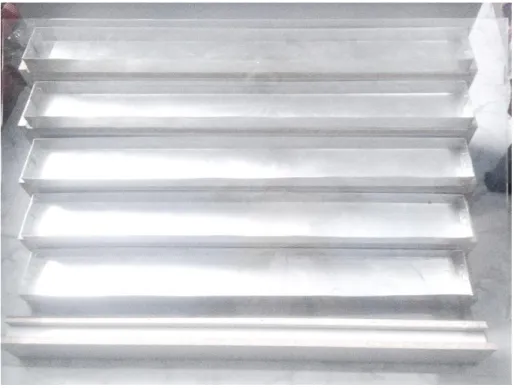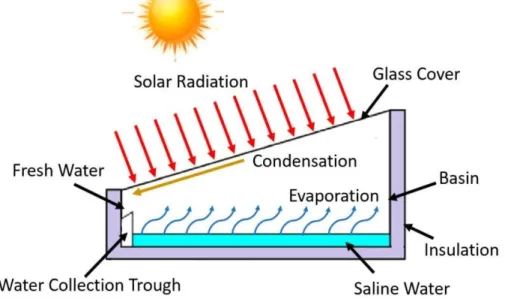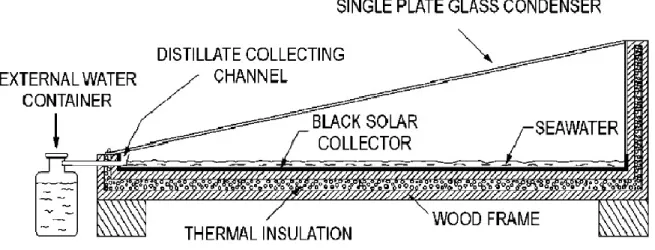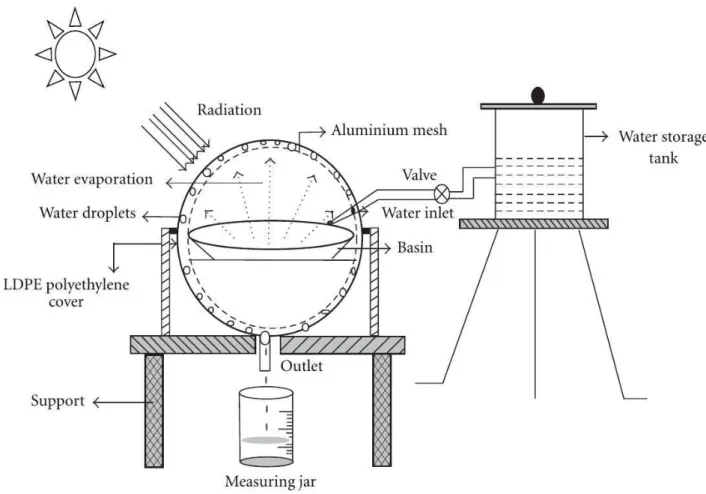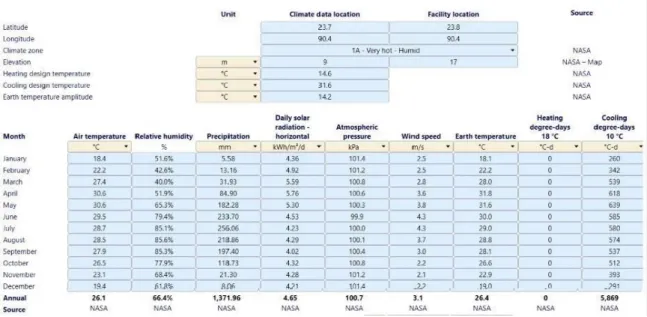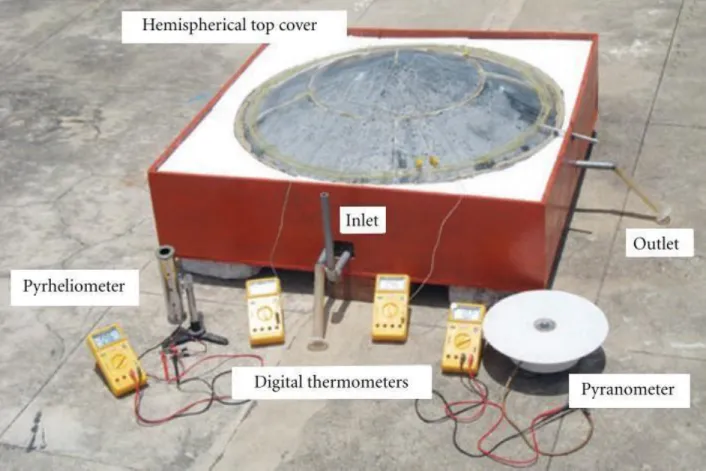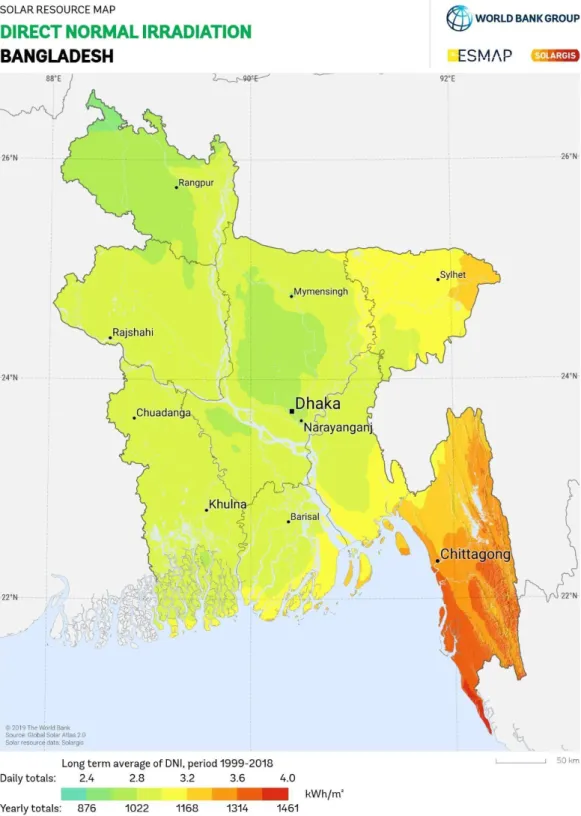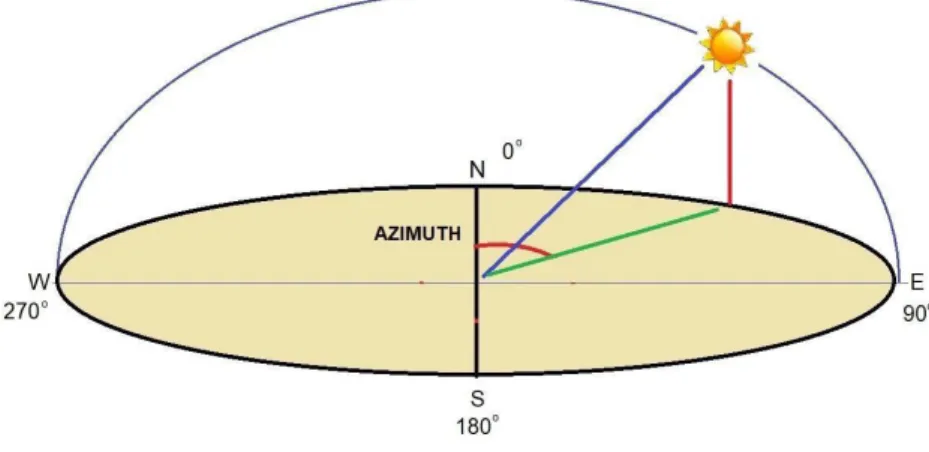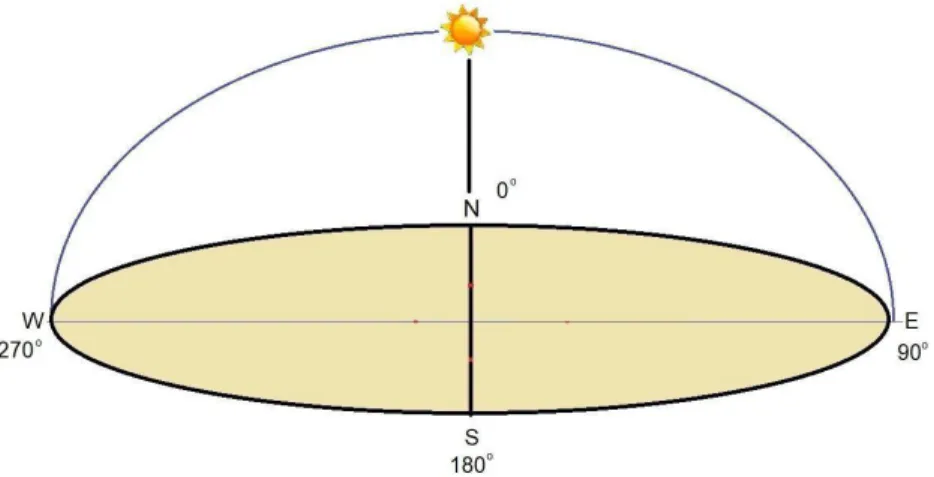We would also like to thank the members of my committee for giving us such a great time and for your excellent comments and suggestions. So, the primary purpose of this research is to increase the production rate and design it as a cost-effective one. The style has polystyrene foam as the wick material, copper wire mesh as the heat storage medium and external reflectors to increase the amount of water production.
Evaporative Heat Transfer Rate (W/m2K) QCwgi Convective Heat Transfer Rate (W/m2K) QRwgi Radiative Heat Transfer Rate (W/m2K) Vw. Kg Thermal conductivity of glass cover (W/mK) Kw Thermal conductivity of water (W/mK) Li Thickness of insulation (m).
Background
Problem Statement
Lower yield rate of the desalination plant; time-consuming and the device cannot be used without adequate availability of sunlight; high foreign investment in equipment per unit of water production is required. Some of the factors involved in solar still water production are air velocity, water depth, pool absorption, sun angle, atmospheric pressure and temperature. In countries with many seasons, the yield rate varies from season to season.
Manufacturing solar stills with cost-effective materials ensures clean drinking water at the cheapest possible price.
Objectives
The Main Scopes of the Project
Solar energy is still a process where it absorbs solar radiation and uses that heat energy to evaporate the supplied water. For example, salt and impure water can be separated from the salts and impurities with the help of solar radiation.
Heat Transfer Process in Solar Still
Different Types of Solar Stills
Types of Solar Still Models Available
- Single-effect single slope solar still
- Pyramid Solar Still
- Spherical Shaped Solar Still
- Hemispherical Solar Still
In a pyramid type of solar, two transparent covers are placed on top of the water bowl. Pyramidal solar power is considered more efficient according to Arunkumar et al. A circular absorption basin is located in the center of the device which is covered with black paint just to absorb the maximum solar radiation falling on it.
According to the experimental result, the spherical yield of the solar station is observed to be 30% more than that of the conventional solar station. According to Arunkumar et al. (2012b) (6), the production of distilled water from the hemispheric sun still varies from 3580 to 3680 ml/m2/day.
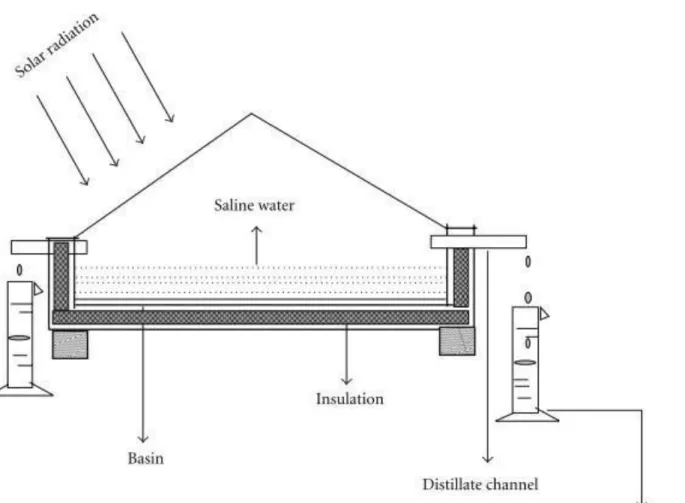
Potential of Solar Energy in Bangladesh
From the above table, it can be noted that for the implementation of solar power plants in Bangladesh, an abundance of solar radiation is a great potential. From the map of Bangladesh in Figure 2.7, it can be seen that solar radiation falls in this area about 300 days a year. The southeastern part of Bangladesh, which is close to the equator, receives the most solar radiation from the sun.
The central part of Bangladesh, where Dhaka is located, receives the least amount of sunlight. Thus, the introduction of solar energy based devices in the South Eastern regions will give the maximum output as compared to other regions.
Solar Resource Assessments
Solar Azimuth Angle, φ
At the equinoxes, the sun rises directly due east and sets directly due west regardless of latitude, so the azimuth angle is 90◦ at sunrise and 270◦ at sunset.
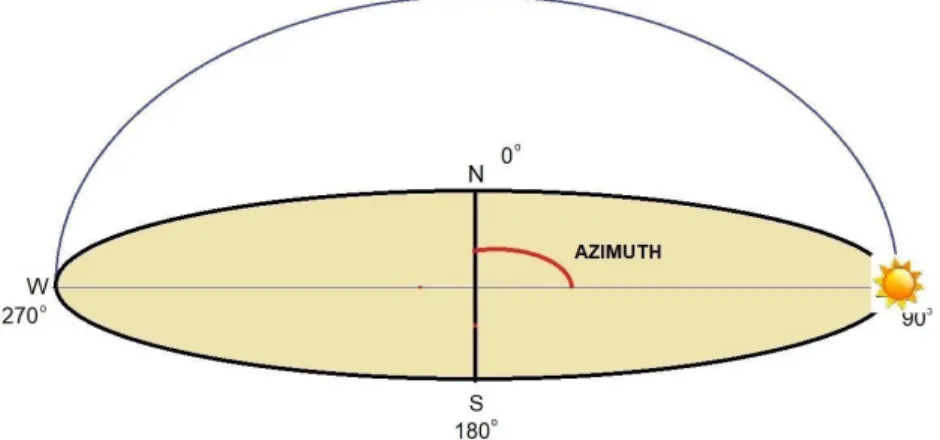
Elevation Angle, α
Domestic Water Consumption in Bangladesh
Codes/Guidelines/Standards
WHO Recommendations
The productivity of a solar light can be increased by 125% over conventional stationary ones by using internal and external reflectors. Compared to the heat capacity of the sink water, the heat capacity of insulating materials used in solar power is still small. According to Omara et al, the production of a solar equipment will increase by 125% by using external top and bottom reflectors.
The side view of the designed solar cell still designed in Autodesk Fusion360 with detailed labels is shown below. The solar still's reflector angles must be varied according to the season to get the maximum output. According to the final design, the estimated costs for a single solar cell are shown in the table below.
Figure: Collection of parameters from the QC department of Solar Still by Practically Table 5.2: Fixed parameters of the computer model. The internal heat and mass transfer coefficient in a solar still is based on three parameters called convection, radiation and evaporation. In the designed solar still, various improvement parameters are adopted to achieve the best efficiency.
According to the local market survey, each unit of solar power will cost around BDT 10970 tk. Effect of shape of the absorber surface on the performance of stepped type solar.
Water Purification
Oxidation
Commercial Products in Bangladesh
The system meets the critical need for clean drinking water and produces clean water from saline or polluted sources. It provides safe, high-quality drinking water from any source, including seawater, freshwater, and polluted or contaminated water, from any source. It also incorporates ZLD (Zero Liquid Discharge) technology when the plates are in series, converting the remaining brine into drinking water and precious fractionated salts (F-cubed.
Previous Research Activities
Analysis shows that the production rate of solar energy mainly depends on the intensity of solar radiation and that the production rate is high in the summer. Tubular solar energy systems can be built from locally available materials to produce saltwater from remote, coastal and arid areas to meet freshwater needs of all sizes.
Design Parameters
- Number of Steps in the Still Basin
- Water Depth
- Top Cover Related Parameters
- Wick Material Related Parameters
- Heat Storing Medium Related Parameters
- Insulation Related Parameters
- Reflectors Related Parameters
- Additives Related Parameters
The maximum distillation was 4.28 liters/day using an aquatic coral fleece fabric with a stepped wire mesh absorption plate. Aquatic coral fleece with a stepped wire mesh absorber can increase the output productivity of a still by 71.2% and 58%, respectively, when polystyrene sponge with a stepped wire mesh is used. In addition, it can be estimated that in the context of Bangladesh, for the construction of cost-effective solar stills for desalination, aquatic coral fleece can be used to provide the best results.
But it is the common characteristic of coral fleece fabric to degrade performance if exposed to water for a long time, so as an alternative, polystyrene foam can be used as an absorbent material. According to the study, Hansen et al. productivity is reached up to 3.9 l/day and it is also commercially available. According to Patel and Kumar, productivity increases by 11.24% when energy absorbing medium is implemented in the still.
Productivity is increased using aluminum infill as an energy storage system under the absorber plate Abdullah (2013) (1). The solar panel can be made of copper foil, with a thermal conductivity of about 380 W/mK to 401 W/mK depending on the grade of the material and various other factors Cengel and 1Boles(2015) (9). Copper can be used because it has a high thermal conductivity at a low cost, thus increasing the overall production of the season. 26% heat loss can be avoided by using sawdust as insulation (25 mm thick) and distillation productivity can be increased by 7%.
Various experiments with internal and external reflectors have been carried out in Tanaka and Omara et al.(2014). Various additives such as PCM and nanoparticles play a significant role in improving the output of a solar cell. Water productivity can be increased by 30% by using CuO nanoparticles as an additive Gupta et al.
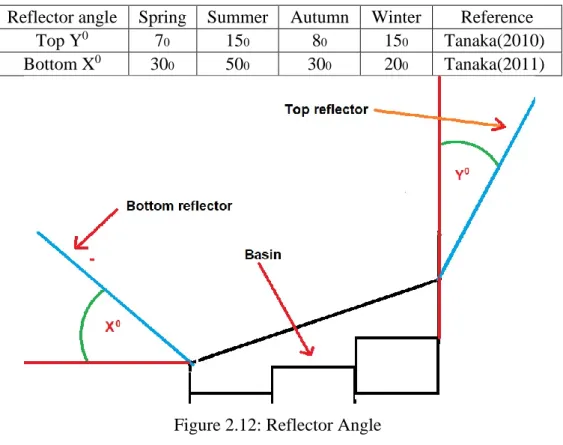
Calculation Formulas
- Heat Transfer Related Formulas
- Important Assumptions for the Computational Model
- Basin and Tray Related Parameters
- Wick Material and Heat Storing Medium Related Parameters
- Top Cover Related Parameter
- Insulation and Water Flow Related Parameters
- Reflectors Related Parameters
The pool will be painted with black spray paint, which has a solar absorption αp= 0.97 Cengel and Boles (2015) (9). The parameters are taken as experimental values and will be optimized according to the simulation results. Therefore, it will be a better choice to use polystyrene sponge instead of water coral fleece to reduce the maintenance cost of the still.
The wick is wrapped around a copper plate or mesh with the aim of increasing productivity. The cross-sectional area and diameter of the copper mesh are not yet justified, but for experimental validation, the parameters will be selected according to El-Said et al. But in this project, the amount of nanoparticles to be used is not yet justified and will be done if the required output not removed from the existing system.
For preliminary analysis, the thickness of the glass is 3 mm and the surface of the glass is about 0.67 m2. The latitude of Dhaka city is 23.70 and the slope of the cover to the ground should be equal to the latitude of the site to achieve the maximum performance (El-Samadony et al. The pool frame is made of wood, which is one of the best insulation material after rubber.
Rubber will also be used as an improved insulating medium, placed under and on the sides of each tray. To fill the basin with feed water, the upper part of the basin has a hole through which a tube will be inserted. When the entire basin is filled with the required water, the excess waste water will flow out of the system via a small hole cut in the bottom of the still.
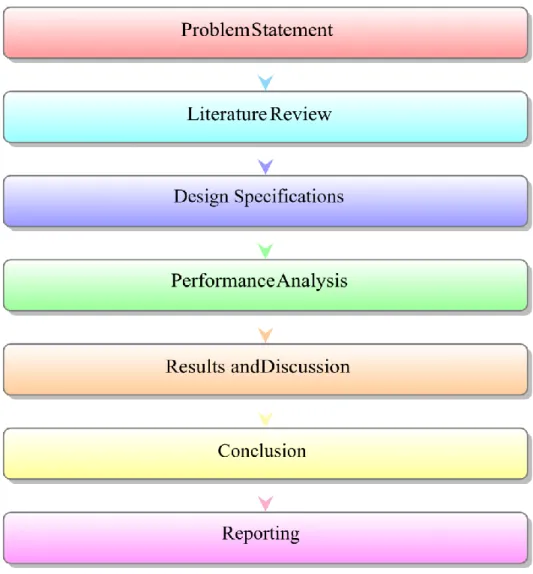
Final Design Specifications
- Basin and Tray Related Parameters
- Wick Material Related Parameters
- Heat Storing Medium Related Parameters
- Top Cover Related Parameters
- Insulation and Water Flow Related Parameters
- External Reflectors Related Parameters
- Cost Estimation of the Solar Still
When the sink overflows, the excess waste water will flow out of the system via a small hole cut into the bottom of the still. Thickness of the mirror has a negligible effect on the performance of stationary so this parameter was not considered in the calculation model and final design. Performance of solar energy is based on productivity, efficiency as well as internal heat and mass transfer coefficient.
Therefore, from the analysis, it is concluded that solar still is very site specific and works better if it is placed in any location with abundant solar insolation. In this research, the main and most important objective is to design a cost-effective solar still from the perspective of Bangladesh. Because solar energy still needs solar radiation to operate, it is very location dependent and therefore, if you place it anywhere, it may not provide the required power.
Some additional improvements can be made and a clear understanding of the computational model is needed. In this case, the computational model will be validated with performance results of the still experimental model. Influence of the inclination angle of the glass cover on the rate of radiant heat transfer within staged solar.
Software to analyze solar photos and an experimental study on the effects of the canopy. Comparative Performance Evaluation of Modified Passive Solar Still Using Sensible Heat Storage Material and Increased Frontal Height.
